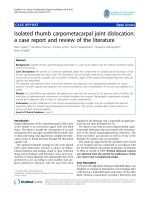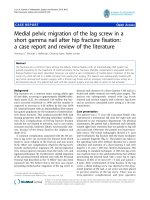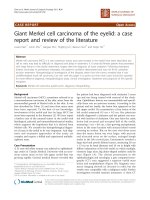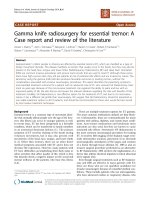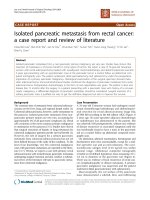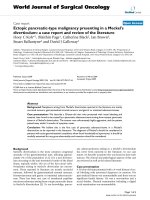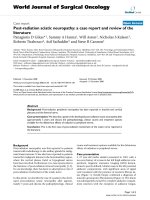báo cáo khoa học: " Lingual infarction in Wegener''''s Granulomatosis: A case report and review of the literature" pot
Bạn đang xem bản rút gọn của tài liệu. Xem và tải ngay bản đầy đủ của tài liệu tại đây (1.08 MB, 5 trang )
BioMed Central
Page 1 of 5
(page number not for citation purposes)
Head & Face Medicine
Open Access
Case report
Lingual infarction in Wegener's Granulomatosis: A case report and
review of the literature
Lachlan M Carter*
1
and Eitan Brizman
2
Address:
1
Specialist Registrar, Maxillofacial Surgery, Leeds Dental Institute, Clarendon Way, Leeds, LS2 9LU, UK and
2
Senior House Officer,
Maxillofacial Surgery, Leeds Dental Institute, Clarendon Way, Leeds, LS2 9LU, UK
Email: Lachlan M Carter* - ; Eitan Brizman -
* Corresponding author
Abstract
Wegener's granulomatosis (WG) is a multi-system disease, characterised by the triad of necrotising
granulomata affecting the upper and lower respiratory tracts, disseminated vasculitis and
glomerulonephritis. Oral lesions are associated with up to 50% of cases, although are rare as a
presenting feature. The most common oral lesions associated with WG are ulceration and
strawberry gingivitis. We review the literature regarding oral manifestations of WG and present a
case of lingual infarction, an extremely rare oral lesion associated with WG, in a severe, rapidly
progressive and ultimately fatal form of the disease.
Background
Wegener's Granulomatosis (WG) is a multi-system dis-
ease, characterised by the triad of necrotising granulomata
affecting the upper and lower respiratory tracts, dissemi-
nated vasculitis and glomerulonephritis. WG is included
in the ANCA-associated small-vessel vasculitis group
(including also microscopic polyangiitis, Churg-Strauss
syndrome and renal-limited vasculitis). Oral lesions are
associated with up to 50% of cases, although are rare as a
presenting feature. The most common oral lesions associ-
ated with WG are ulceration and strawberry gingivitis. We
present a case of lingual infarction, an extremely rare oral
lesion associated with WG, in a severe, rapidly progressive
and ultimately fatal form of the disease.
Case Report
A 56 year old female presented with headache, sinus pain,
shortness of breath, cough productive of green sputum
and haemoptysis. She had a history of bronchiectasis
(diagnosed at age 20), hypertension, and a three month
history of sinus problems with associated bilateral hearing
loss. Chest radiograph revealed bilateral pleural effusions
with apical opacities. Blood investigations revealed a C-
reactive protein (CRP) of 454 mg/L and a creatinine of 76
umol/L. An initial diagnosis of lower respiratory tract
infection was made and treatment with intravenous
amoxicillin and erythromycin started. Pseudomonas was
cultured from sputum after seven days, at which point
intravenous gentamicin was started. She then developed
pulmonary oedema and the haemoptysis worsened. Renal
impairment also developed (urine protein/creatinine
index 14395, urine protein 5.47 g/L, urine creatinine 3.8
mmol/L) and subsequently the gentamicin therapy was
stopped. Her respiratory and renal function continued to
deteriorate and she developed anterior t-wave inversion
on ECG. Pulmonary haemorrhage secondary to systemic
vasculitis was suspected. Blood investigations revealed
haemoglobin (Hb) 9.0 g/dL, white cell count (WCC)
22.15 10
9
/L, platelets (PLT) 522 10
9
/L, CRP 227 mg/L,
creatinine 159 umol/L, and positive cytoplasmic pattern
anti-neutrophil cytoplasmic antibodies (cANCA) (ANCA
protease-3 (PR3) 18 u/ml and ANCA myeloperoxidase
Published: 21 August 2008
Head & Face Medicine 2008, 4:19 doi:10.1186/1746-160X-4-19
Received: 29 May 2007
Accepted: 21 August 2008
This article is available from: />© 2008 Carter and Brizman; licensee BioMed Central Ltd.
This is an Open Access article distributed under the terms of the Creative Commons Attribution License ( />),
which permits unrestricted use, distribution, and reproduction in any medium, provided the original work is properly cited.
Head & Face Medicine 2008, 4:19 />Page 2 of 5
(page number not for citation purposes)
(MPO) 1 u/ml). A diagnosis of Wegener's granulomatosis
was considered most likely and intravenous methylpred-
nisolone commenced. No upper airway lesions were iden-
tified on nasal endoscopy so no tissue biopsy could be
taken. As a result of worsening respiratory and renal func-
tion she was intubated, ventilated and inotropic support
with noradrenaline started. Nasogastric feeding was also
commenced and plasmaphoresis undertaken. A renal
biopsy was planned but she became progressively anae-
mic Hb 5.7 g/dL, thrombocytopenic PLT 35 10
9
/L, and
her liver function deteriorated with a prothombin time of
31 s, making renal biopsy unsafe in the presence of coag-
ulopathy. Gastrointestinal haemorrhage was suspected as
the cause of anaemia. Oesophago-gastro-duodenoscopy
(OGD) was performed which revealed oesophagitis, gas-
tritis and duodenitis consistent with vasculitis, see figure
1. These lesions were injected with epinephrine and intra-
venous omeprazole was commenced. At this point, 19
days after initial presentation, sloughing of her lingual
mucosa was noted, see figure 2. The mucosal sloughing
involved the entire anterior two thirds of her tongue bilat-
erally. After the addition of intravenous cyclophospha-
mide her respiratory and renal function stabilised. The
lingual sloughing persisted, and over the next 14 days pro-
gressed to an area of well demarcated necrosis of the ante-
rior two thirds of the tongue bilaterally, see figure 3. The
necrotic area began to separate but unfortunately she
developed further pulmonary haemorrhage and her renal
and cardiac function continued to deteriorate despite
plasmaphoresis and inotropic support. Her condition was
deemed irretrievable and supportive care was withdrawn.
She died 48 days after initial presentation with the cause
of death reported as multi-organ dysfunction syndrome
(MODS) secondary to Wegener's granulomatosis. No post
mortem examination was performed.
Discussion
WG was first described by Freidrich Wegener in 1936 and
1939 [1,2]. In 1954, Godman and Churg further deline-
ated the clinical and pathological features by describing
the classical triad of necrotising granulomata affecting the
upper and lower respiratory tracts, disseminated vasculitis
and glomerulonephritis [3]. The aetiology of WG remains
unknown.
In Europe the prevalence of WG is 5 cases per 100,000
population. The incidence is greater in Northern Europe.
WG can occur in all racial groups, but predominantly
affects Caucasians. Both sexes are affected equally. WG
affects a wide age range (8–99 years) with a mean age at
diagnosis of 40 years [4]. Historically WG, if untreated,
had a poor prognosis with a mean survival time of 5
months [5]. In recent decades prognosis has improved
with the introduction of immunosuppressive therapy
using glucocorticosteroids and cyclophosphamide [6].
WG can be rapidly progressive or mild and indolent. Gen-
eralised symptoms such as fever, weight loss, fatigue and
malaise may be present. Specifically, pulmonary manifes-
tations such as cough, haemoptysis and pleuritis are the
most common presenting symptoms. Renal disease can
be the presenting feature in up to 18% of patients [6].
Renal involvement is characterised by abnormal renal
function with red cell casts in urinalysis, and glomeru-
lonephritis on renal biopsy. Renal involvement and a late
age at onset are associated with an increased risk of mor-
tality [7]. 80–90% of patients will have renal and/or pul-
monary involvement at some time in their disease
process.
Endoscopic views of gastrointestinal lesions consistent with vasculitis: A oesophagus, B gastric mucosa, C duodenal mucosaFigure 1
Endoscopic views of gastrointestinal lesions consistent with vasculitis: A oesophagus, B gastric mucosa, C duo-
denal mucosa.
Head & Face Medicine 2008, 4:19 />Page 3 of 5
(page number not for citation purposes)
WG can also affect the eyes, skin, joints, nervous system,
ear, nose and throat [8]. The most common anatomical
site for presenting lesions of WG is the upper airway. Up
to 30% of patients may present with nasal problems
including nasal obstruction, ulceration, septal perfora-
tion, mucus discharge, or epistaxis [9].
Diagnosis of WG is based on a combination of clinical,
histological, biochemical and immunological features.
Inconsistency of histopathological findings can make
diagnosis based on this method in isolation difficult. In
1985 diagnosis was aided by the description of anti-neu-
trophil cytoplasmic antibodies (ANCA) associated with
WG [10]. Two forms exist: cytoplasmic (cANCA) of which
the principal target is protease-3 (PR3) and perinuclear
(pANCA) which is directed against myeloperoxidase
(MPO). These targets are antigens stored in the
azurophilic granules of neutrophils and monocytes.
Lesions of the oral mucosa occur in 6–50% of patients
with WG [11,12]. Duna et al reported oral lesions in 6–
13% of patients but as the presenting feature in only 2%
[9]. Oral and oropharyngeal ulcers resembling large aph-
thous ulcers are the most common oral lesion. Indeed at
autopsy nearly all patients were reported to have oropha-
ryngeal ulceration [1,13]. Hyperplastic gingivitis, dark-red
to purple in colour with a granular surface, resembling an
over-ripe strawberry, either generalised or affecting a sin-
gle dental papilla, can be considered specific to WG [14-
21]. In fact, the combination of 'strawberry gingivitis'
exhibiting pseudoepitheliomatous hyperplasia, microab-
scesses and multi-nucleate giant cells upon biopsy with
severe systemic upset can be considered diagnostic for WG
[15]. Oro-antral fistulae [22], palatal osteonecrosis and
labial mucosal nodules have also been reported [23]. WG
can also affect the salivary glands with reported cases
affecting the parotid, submandibular and sublingual sali-
vary glands [24-26].
Lingual necrosis is a rare oral manifestation with only two
previously reported cases. Bachmeyer et al reported a case
of necrotic lingual ulceration which resolved with immu-
nosuppressive therapy [23]. Rodgers et al reported a case
of bilateral infarction of the tongue associated with a
severe and rapidly progressive form of WG in 1992 [27].
The patient died 39 days after onset of symptoms (18 days
after presentation). At post mortem examination the ante-
rior two thirds of the tongue were infarcted. Our case was
also fatal, exhibiting a similar clinical course with a simi-
lar anatomical distribution of lingual infarction. WG
affects the small arteries of the lung and kidney causing
pulmonary and renal infarction [20,27]. In our case the
lingual arteries may have been similarly affected but
unfortunately post mortem examination was not per-
formed, therefore we cannot confirm that the lingual inf-
arction was solely a result of lingual end-arteritis.
Lingual infarction can occur secondary to embolism, radi-
otherapy [28], tumour infiltration, radical neck dissection
[29], transient ischaemic attack [30], and cardiac arrest
[31]. Lingual infarction has also been reported in cranial
arteritis, giant cell arteritis [32-35], and microscopic poly-
angiitis (MPA) [36]. WG and MPA share many similar
clinical and histological features. Oral, upper airway, pul-
monary and renal vasculitis are present in both condi-
tions, however the vasculitis associated with WG is
Sloughing of the lingual mucosaFigure 2
Sloughing of the lingual mucosa.
Necrosis of anterior two thirds of tongueFigure 3
Necrosis of anterior two thirds of tongue.
Head & Face Medicine 2008, 4:19 />Page 4 of 5
(page number not for citation purposes)
granulomatous whereas MPA exhibits non-granuloma-
tous vasculitis [36].
Most patients with Wegener's granulomatosis exhibit
cANCA with PR3 specificity and 25% exhibit pANCA with
MPO specificity. In contrast microscopic polyangiitis
exhibits cANCA with PR3 specificity in approximately
30% of patients and pANCA with MPO specificity in 60%
of patients [36,37]. A positive ANCA result suggests a sys-
temic vasculitis but in the absence of a tissue biopsy,
cANCA/pANCA distribution may suggest either WG or
MPA but cannot definitively differentiate between the two
diagnoses. In our case a tissue biopsy could not be per-
formed safely due to persistent thrombocytopenia and a
post mortem examination was not performed. Therefore
the presence of granulomatous vasculitis was not con-
firmed histologically but the histological differential diag-
nosis can be complicated in that not all biopsy material
associated with WG exhibits the classical pathological
triad of granulomatous infiltration, necrosis and vasculitis
[38]. The clinical, biochemical and immunological fea-
tures of our case were suggestive of a WG diagnosis.
Early diagnosis is important, expediting aggressive immu-
nosuppressive therapy with glucocorticosteroids and
cyclophosphamide, which can potentially limit a more
severe systemic disease progression. Other treatment
options include the use of trimethoprim and sulfameth-
oxazole either as a stand alone treatment or in combina-
tion with glucocorticosteroids and cyclophosphamide [9].
More recent treatment options include Cyclosporin, intra-
venous pooled immunoglobulin, anti-CD20 monoclonal
antibodies (Rituximab) and anti-tumour necrosis factor
alpha with the latter two options restricted to refractory
and relapsed disease [39,40]. Regular review and mainte-
nance therapy are also important to identify and prevent
relapse. A multidisciplinary approach must be undertaken
involving oral and maxillofacial surgeons, oral physi-
cians, otorhinolaryngologists, rheumatologists, renal and
respiratory physicians, ophthalmologists, and ITU sup-
portive care if required. WG should be considered in the
presence of oral lesions associated with a systemic illness.
An oral biopsy and blood investigations assessing full
blood count, renal and hepatic function, inflammatory
markers and autoimmune status, specifically cANCA and
pANCA, should be performed.
Oral lesions are associated with the onset of active sys-
temic disease [12]. Therefore isolated oral lesions may
herald the onset of further systemic involvement. Mahr et
al reported that oral, ear, nose or throat involvement was
not associated with survival in their multivariate analysis.
Mahr et al did indicate that granulomatous WG probably
has a more benign course than vasculitic WG [41]. Our
case and the previously reported case of lingual infarction
were associated with a severe, rapidly progressive and ulti-
mately fatal form of WG. Thus lingual infarction as a
result of vasculitis may indicate more aggressive disease.
The severity of oral mucosal lesions, even in the absence
of systemic signs, may therefore reflect or predict the
severity of the generalised systemic disease and indicate a
more aggressive vasculitis.
Competing interests
The authors have no financial and personal relationships
with other people, or organisations, that could inappro-
priately influence (bias) their work, all within 3 years of
beginning the work submitted.
Authors' contributions
LMC and EB prepared the case report, discussion and
manuscript. Both authors read and approved the final
manuscript.
Consent
Written consent for publication of the clinical images
could not be obtained because the patient died before
written consent could be recorded.
Acknowledgements
The authors would like to thank Mr John L. Russell, Consultant Maxillofacial
Surgeon, Leeds Dental Institute for allowing access to his patient for this
case report and for advice in preparation of the manuscript.
References
1. Wegener F: Uber generalisierte, septische Gefaesserkrankun-
gen. Verh Dtsch Ges Pathol 1936, 29:202-227.
2. Wegener F: Uber eine eigenartige Rhinogene Granulomatose
mit besondere Beteilgung des Arteriensystems and der
Nieren. Beitrage Pathologie Anatomie 1939, 102:36-51.
3. Godman GC, Churg J: Wegener's granulomatosis: pathology
and review of the literature. Arch Pathol Lab Med 1954,
6:533-553.
4. Gubbels SP, Barkhuizen A, Hwang PH: Head and Neck manifesta-
tions of Wegener's granulomatosis. Otolaryngol Clin North Am
2003, 36:685-705.
5. Walton EW: Giant-cell granuloma of the respiratory tract
(Wegener's granulomatosis). Br Med J 1958, 2:265-270.
6. Fauci AS, Haynes BF, Katz P: Wegener's granulomatosis: pro-
spective clinical and therapeutic experience with 85 patients
for 21 years. Ann Intern Med 1983, 98:76-85.
7. Aasarod K, Iverson BM, Hammerstrom J, Bostad L, Vatten L, Jorstad
S: Wegener's granulomatosis: clinical course in 108 patients
with renal involvement. Nephrol Dial Transplant 2000, 15:611-618.
8. De Remee RA, McDonald TJ, Harrison EJJ, Coles DT: Wegener's
Granulomatosis, Anatomic Correlates, A Proposed Classifi-
cation. Mayo Clin Proc 1976, 51:777-781.
9. Duna GF, Galperin C, Hoffman GS: Wegener's granulomatosis.
Rheum Dis Clin North Am 1995, 21:949-986.
10. Van der Woude FJ, Rasmussen N, Lobatto S: Autoantibodies
against neutrophils and monocytes: tool for diagnosis and
marker of disease activity in Wegener's granulomatosis. Lan-
cet 1985, 1:425-429.
11. Patten SF, Tomeki KJ: Wegener's granulomatosis: Cutaneous
and oral mucosal disease. J Am Acad Dermatol 1993, 28:710-718.
12. Frances C, Du LT, Piette JC, Saada V, al : Wegener's granuloma-
tosis. Dermatological manefestations in 75 cases with clin-
icopathologic correlation. Arch Dermatol 1994, 130:861-867.
13. Wegener F: Die pneumogene allgemeine Granulomatose
(PG) - sog. Wegnersche Granulomatose. In Lehrbuch der spe-
Publish with Bio Med Central and every
scientist can read your work free of charge
"BioMed Central will be the most significant development for
disseminating the results of biomedical research in our lifetime."
Sir Paul Nurse, Cancer Research UK
Your research papers will be:
available free of charge to the entire biomedical community
peer reviewed and published immediately upon acceptance
cited in PubMed and archived on PubMed Central
yours — you keep the copyright
Submit your manuscript here:
/>BioMedcentral
Head & Face Medicine 2008, 4:19 />Page 5 of 5
(page number not for citation purposes)
ziellen pathologischen Anatomie, Ergaenzungsbans, I/1 Edited by: Stae-
mmler M. Berlin, De Gruyter; 1967:225-299.
14. Lilly J, Todd J, Lew D, Vincent S, Lilly G: Wegener's granulomato-
sis presenting as oral lesions. A case report. Oral Surg Oral Med
Oral Pathol Oral Radiol Endod 1998, 85:153-157.
15. Napier SS, Allen JA, Irwin CR, McCluskey DR: Strawberry gums: a
clinicopathological manifestation diagnositc of Wegener's
granulomatosis? J Clin Pathol 1993, 46:709-712.
16. Allen CM, Camisa C, Saleweski C, Weiland JE: Wegener's granulo-
matiosis: report of three cases with oral lesions. J Oral Maxil-
lofac Surg 1991, 49:294-298.
17. Eufinger H, Machtens E, Akuamoa-Boateng E: Oral manifestations
of Wegener's granulomatosis. Review of the literature and
report of a case. Int J Oral Maxillofac Surg 1992, 21:50-53.
18. Glass EG, Lawton LR, Truelove EL: Oral presentation of Wege-
ner's granulomatosis. JADA 1990, 120:523-525.
19. Cohen PS, Metzler JA: Strawberry gums. A sign of Wegener's
granulomatosis. JAMA 1981, 246:2610-2611.
20. Raustia AM, Autio-Harmainen HI, Knuuttila MLE, Raustia JM: Ultras-
tuctural findings and clinical follow-up of 'strawberry gums'
in Wegener's granulomatosis. J Oral Pathol 1985, 14:581-587.
21. Scott J, Finch LD: Wegener's granulomatosis presenting as gin-
givitis. oral Surg Oral Med Oral Pathol 1972, 34:920-933.
22. Edwards MB, Buckerfield JP: Wegener's granulomatosis: A case
with primary mucocutaneous lesions. Oral Surg Oral Med Oral
Pathol 1978, 46:53-63.
23. Bachmeyer B, Petitjean B, Testart F, Richecoeur J, Ammouri W, Blum
L: Lingual necrosis as the presenting sign of Wegener's gran-
ulomatosis. Clin Exp Dermatol 2006, 31:321-322.
24. Berge S, Niederhagen B, von Lindern JJ, Appel T, Reich RH: Salivary
gland involvement as an initial presentation of Wegener's
disease. A case report.
Int J Oral Maxillofac Surg 2000, 29:450-452.
25. Lustmann J, Segal N, Markitziu A: Salivary gland involvement in
Wegener's granulomatosis. A case report and review of the
literature. Oral Surg Oral Med Oral Pathol Oral Radiol Endod 1994,
77:254-259.
26. Crean SJ, Adams R, Bennett J: Sublingual gland involvement in
systemic Wegener's granulomatosis: a case report. Int J Oral
Maxillofac Surg 2002, 31:104-106.
27. Rodgers H, Quirke P, Lipkin GW, Brownjohn AM: Infarction of the
tongue in Wegener's granulomatosis. Br J Clin Pract 1992,
46:268-269.
28. Miller SH, Rudolph R: Healing in the irradiated wound. Clin Plast
Surg 1990, 17:503-508.
29. Gault DT: Tongue necrosis after radical neck dissection. Head
Neck Surg 1988, 10:344-345.
30. Orita Y, Ogawara T, Yorizane S, Nannba Y, Akagi H, Nishizaki K:
Necrosis of the tongue after transient ischaemic attack. Oral
Surg Oral Med Oral Pathol Oral Radiol Endod 2000, 89:316-318.
31. Libersa P, Loison-Blanchard C, Nawrocki L, Duquesnoy S: Bilateral
necrosis of the tongue consecutive to cardiac arrest. J Oral
Maxillofac Surg 2002, 60:322-323.
32. McRorie ER, Chalmers J, Campbell IW: Lingual infarction in cra-
nial arteritis. Br J Clin Pract 1994, 48:280.
33. Crevitis I, Hermans R, Wilms G, Baert AL: Tongue necrosis as a
complication of temporal arteritis: CT and angiographic
findings. J Belg Radiol 1996, 79:258-259.
34. Biebl MO, Hugl B, Posch L, al : Subtotal tongue necrosis in
delayed diagnosed giant cell arteritis: a case report. Am J
Otolaryngol 2004, 25:438-441.
35. Ciantar M, Adlam DM: Glossodynia and necrosis of the tongue
caused by giant cell arteritis. Br J Oral Maxillofac Surg 2007,
doi:10.1016/j.bjoms.2007.03.014:.
36. Shiboski CH, Regezi JA, Sanchez HC, Silverman SJ: Oral lesions as
the first clinical sign of microscopic polangiitis: a case report.
Oral Surg Oral Med Oral Pathol Oral Radiol Endod 2002, 94:707-711.
37. Savige J, Gillis D, Benson E, Davies D, Esnault V, Falk RJ, al : Interna-
tional concensus statement on testing and reporting of
antineutrophil cytoplasmic antibodies. Am J Clin Pathol 1999,
111:507-513.
38. Devaney KO, Travis WD, Hoffman G, Leavitt R, R. L, Fauci AS: Inter-
pretation of Head and Neck Biopsies in Wegener's Granulo-
matosis. Am J Surg Pathol 1990, 14:555-564.
39. Allen NB, Caldwell DS, Rice JR: Cyclosporin A therapy for
Wegener's granulomatosis. Adv Exp Med Biol 1993, 336:473-476.
40. Jayne DR, Lockwood CM: Pooled intravenous immunoglobulin
in the management of systemic vasculitis. Adv Exp Med Biol
1993, 336:469-472.
41. Mahr A, Girard R, Agher R, Guillevin L: Analysis of factors predic-
tive of survival based on 49 patients with systematic Wege-
ner's granulomatosis and prospective follow-up. Rheumatology
2001, 40:492-498.
